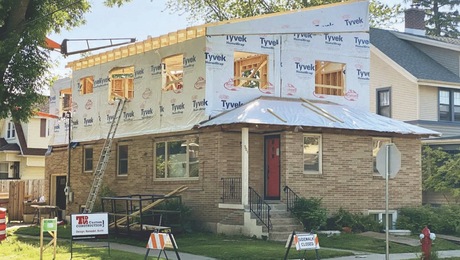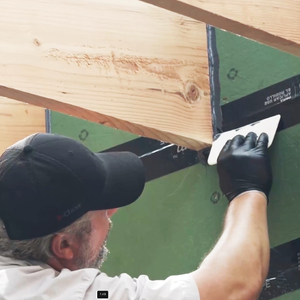repairing a small part of a shingle roof
Hello! I have a contemporary house with high ceilings. I have 18 years on a 15 year roof. I haven’t replaced it for 2 reasons: one is a significant planned addition and I want all of the new roofing done at once, the other is that I want to convert the roof to one I read about here many years ago called either a Boston or New England double roof. Unfortunately, that will be next year (was supposed to be this year) and I have maintenance that needs to be done NOW. 2 skylights were originally installed WRONG without ventilation (making things worse, they are close together) so I build up MASSIVE ice dams, which have leaked under the roof and down the walls at times. I am sure that I have structural damage that needs to be repaired. At this point, I would like to replace the shingles in the area around the skylights so I can make it through the winter with minimal damage. Can I do that, just replacing a few shingles? I already have cables on the roof and rake the roof edges every time it snows. Those help, but the dams still cause some problems (they form immediately when it starts snowing). Also, can anyone give me a ballpark of the cost difference for adding the double roof vs. simply re-roofing a 2500 sp ft 2 story house? It requires removing all of the old roof, putting down new felt, putting 2x2s down the rafters, putting down new decking, then roofing that and replacing the fascia (correct term?) to account for the added roof height. Thanks! Chuck Crisler, snowy New Hampshire


















Replies
Chuck, if your roof is a three-tab shingle that's 18 years old, chances aren't good for replacing "sections"--the tabs are too brittle from age and you'll end up breaking off more than what was originally damaged.
As for doing the double roof, whay not just spend a little extra and do the whole thing with a waterproof underlayment (like Grace I&W or GAF Weatherwatch) instead of felt? It would be much less expensive than furring and new decking.
Jason Pharez Construction
Framing & Exterior Remodeling
My concern about putting watershield under the entire roof is that is only addressing the symptom. I obviously have a roof that is not designed properly and doesn't ventilate well. Even the areas without the skylights build ice dams, though they are smaller. My intention is to provide good ventilation to the entire roof system for many years. It is clear that the original builders didn't have the same committment that I have.
Good strong point about the brittleness of the aged shingles, buddy. The best temp solution could be a blue tarp! Seen any around lately?
Welcome to the Taunton University of Knowledge FHB Campus at Breaktime. where ... Excellence is its own reward!
Commitment probably is not the right fixation here. They probably did the job according to the standards of that day and time.
ice and water shield around a shylight area is standard practice and is not indicative of otherwise poor work. It is simply good backup and a sign of a conscientious roofer.
Neither is the ventilation the answer to skylight ice damming. A skylight blocks the ventilation that would pass that part of the roof. The answer is in better insulation around the skylight. I use spray foam in that area to seal things tight.
but you have a conundrum here, in that you need to do all this now to get it right, but want to wait for another year. Can't help you with that decision.
As far as the double roof idea, I know this as a 'cold roof' and is beneficial where one has a cathedral cieling that is hard to ventilate well. I don't know if your 'high cielings' are vented or not, or the other detals of that situation, but the cold roof approach might be good for you. I would suggest an improvement on it though. instead of merely creating open space, you could lay the felt on the existing sheathing, then apply an inch or 1-1/2" of extruded polystyrene foam (R-5 per inch) or an inch of the foil faced polyisoanurate ( R-7 per inch but less water resistant and less structurally sound) and then lay strapping 3/4" thick over that to set the new sheathing on before finishing the roof. Make sure the joints are tight and fill breaks with spary foam too.
Doing it that way will add to your insualtion package and help the ventilation situation both. I suspect that your problem is more closely tied to insufficient insulation than to the insufficient ventilation, but it is partly both so this adresses both.
of course, since I am limited in what I can see from here, take all this with a grain of salt
Welcome to the
Taunton University of Knowledge FHB Campus at Breaktime.
where ...
Excellence is its own reward!
Thanks for the suggestions! Please don't get me wrong, I am not opposed to a 'belt and suspenders' approach. I will probably put ice shield down under the top roof. I really don't think that the roofers did a substandard job. As you say, they did what was standard at the time. My development is one of the first contemporary ones in the area, so no one had that much experience with what could go wrong. But the framers were awful. The roof is somewhat ventilated, which largely works. There are supposed to be extra venting around skylights that must not be there. I will find out when it gets ripped out next summer.
I honestly don't know how one wopuld run extra venting around a skylight. To give the airflow needed you would have to remove enough framing with a big drill to noticeably weaken the framing - one of those catch 22s in building practice where one need runs head on into another and we have to substitute, compromise, and do the best we can. using foam to eliminate dew points is one good trick.
Welcome to the Taunton University of Knowledge FHB Campus at Breaktime. where ... Excellence is its own reward!